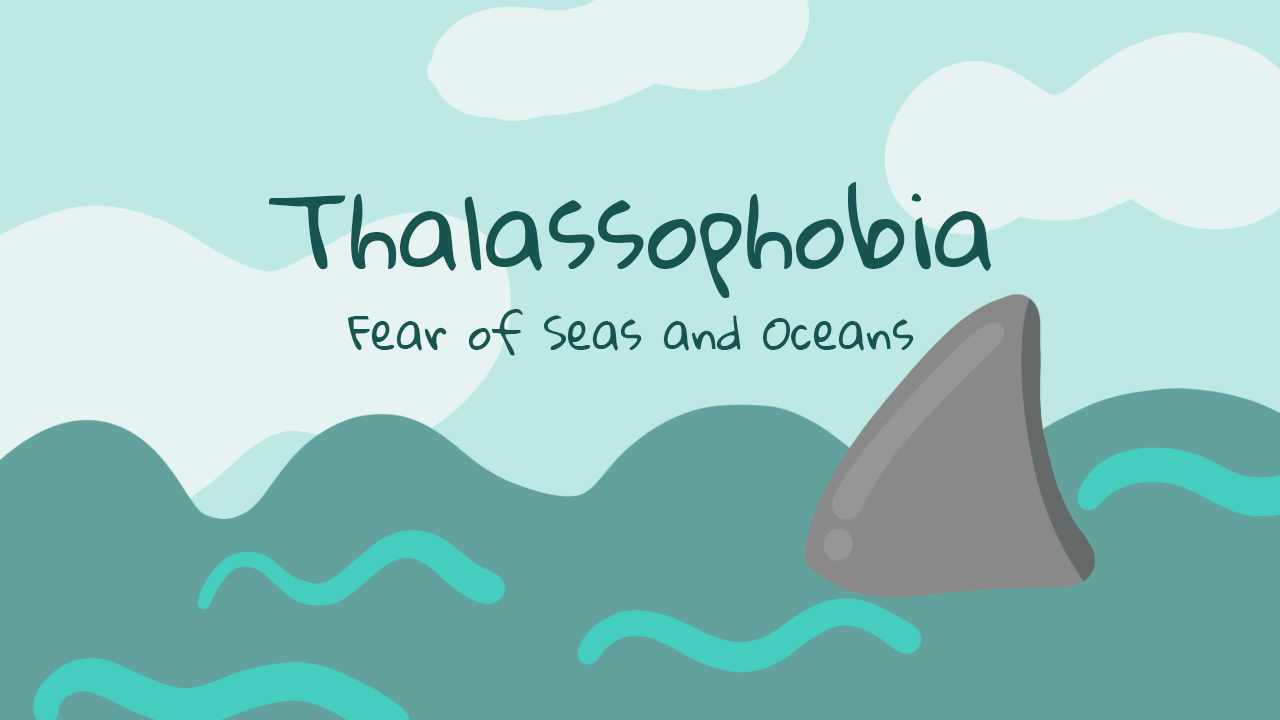
Start feeling better today!
Connect with your therapist today and take control of your life like our 850.000 happy clients.
Get StartedWhat is Thalassophobia?
Fear of the sea, also known as thalassophobia, is a type of phobia that describes an excessive and persistent fear of large, deep, dark bodies of water. As a result of the avoidance behaviors and the fact that they interfere with the functionality of the person's daily life, it is classified as an anxiety disorder.
The symptoms, emergence, and progression of thalassophobia are largely similar to those of other phobias1. It is derived from the Greek words thalassa (sea) and phobos (fear) and is also known as open sea phobia or ocean phobia1, 2.
For someone suffering from thalassophobia, the thought of being away from land, the vast, dark blue view of the sea, and its obscurity are all very frightening. People with sea phobia, as expected, avoid swimming in the sea, sea-related objects and creatures, going to the beach, entering a deep pool, and even witnessing all of these in order to avoid many symptoms that develop as a result of intense and disproportionate fear, anxiety, and negative beliefs mentioned in situations related to the sea and the sea. They might even try to avoid it2.
It happens suddenly when a thalassophobic person sees open seas, oceans, or deep puddles, or when they have to use a watercraft such as a ship or boat2. Even mental images of the sea may be enough to elicit the phobia response in these people.
What are the Symptoms of Thalassophobia (Phobia of the Sea and Ocean)?
Individuals with sea/ocean phobia exhibit a wide range of physical and emotional symptoms and changes, as with all types of phobia. Some of the most distressing symptoms observed in the situations mentioned by a person with sea phobia are as follows:2
- Trembling hands and body
- Sweating
- Dry mouth
- Shortness of breath, pain and a feeling of pressure in the rib cage
- An intense increase in fear and anxiety
- Losing control and an increase in fear of death
- Heart palpitations
- Nausea
- Irritability
- Restlessness, tension
- Fainting
As you can see, the symptoms listed are quite diverse, and examples can be drawn from personal experience. At the same time, these symptoms are common to a wide range of phobias. As with any type of phobia, it is important to remember that all of the symptoms mentioned should be evaluated in the context of the individual's personal history, and that their severity and exposure may vary from person to person. For example, in severe cases, you may experience fainting and intense heart palpitations, whereas someone else may not experience these symptoms at all.
So, why do some of us experience symptoms and intense fear, which can vary even among phobia sufferers, while others do not? Why and how does thalassophobia develop?

Causes of Thalassophobia
The vast and blue waters that captivate some of us are a nightmare for others. As you can see, the seas and oceans are a nightmare for someone who suffers from thalassophobia3. When it comes to the causes of this disparity between people, we now have scientifically based current opinions as a result of research and observations on the subject, though definitive and clear results have not yet been reached.
Biological Causes
The first of these theories holds that the development of thalassophobia may be caused by a biologically based transmission. Despite limited research, this viewpoint contends that the transmission of some fear-related genes from one's ancestors may be effective in the development of thalassophobia. The effect of genetics cannot be ignored under any circumstances, and this is especially true when it comes to phobias and thalassophobia.
Psychosocial Reasons
Furthermore, our general fear of uncertainty is one of the thoughts that is said to reinforce sea phobia. Given the vastness of the seas and our obliviousness of the diversity of living and non-living things within them, this role is understandable.
Other studies, on the other hand, concentrate on the impact of prior experiences on the development of thalassophobia. Conditioning, learning, and traumatic experiences, as they are known, all have an undeniably significant impact on the underlying causes of many psychological problems.
When discussing sea phobia, it is possible to discuss a similar effect. In this sense, having a history of drowning, witnessing drowning, hearing news of sea disasters, or observing the same fear in the person they look up to as a role model can all help to develop thalassophobia.
Although research into the causes of thalassophobia is ongoing, it is clear that many biological and environmental factors can contribute to a fear of the sea. So, how do we overcome thalassophobia2?
The Vicious Cycle of Sea Phobia
As previously stated, thalassophobia can occur for a variety of reasons, and with its physical and emotional symptoms, it can cause avoidance behaviors in any area of a person's life that is related to the sea or water. All of these avoidance behaviors clearly limit the person's ability to engage in daily activities.
On the other hand, due to our excessive fear of the sea, we may experience disproportionate physiological symptoms (accelerated heartbeat, excessive sweating, shivering, etc.) that can actually reach dangerous levels physiologically.
Aside from the unhealthy physiological experiences and restrictions it imposes on daily life, avoidance behaviors such as not swimming in any way, not looking at the sea, or even not sitting on the beach involuntarily reinforce the person's anxiety and negative beliefs.
While avoiding confirms a person's beliefs, he also misses the opportunity to experience what actually occurred when he does not avoid it. The vast majority of people have learned over time that the only truth is to leave immediately or not go at all. As expected, the constant avoidance behavior prevents the child from ever learning that healthy coping methods and water is not actually harmful. In other words, avoidance behavior creates a self-sustaining vicious circle in the long run.

At first glance, avoidance behaviors appear to provide short-term relief and control over sea phobia, but when we look at the process in general, we see that a cycle of anxiety continues. This is possibly a common image at the root of all phobias. Fortunately, this cycle can be broken and the table changed. To overcome thalassophobia, we have effective professional methods as well as social tips. So, how do you treat thalassophobia?
How to Overcome Thalassophobia
To overcome thalassophobia, or a fear of the sea, the cognitive behavioral therapy method, which has been scientifically proven to be effective in phobias, has a one-to-one intervention plan. Together with his or her therapist, the person discovers his or her past experiences, negative beliefs, and thoughts and feelings that affect his or her fears about deep seas and oceans using this method2.
The general goal of phobia treatment is to focus on the avoidance behaviors caused by the phobia while taking the individual's phobia history into account, and to develop new coping strategies in this regard. For this, systematic step-by-step exposure methods are used, and the person gains new knowledge about water, seas, and oceans. While the person gains new experiences in this manner, existing old beliefs are gradually replaced by new ones2.
5 Tips to Overcome Sea Phobia
On the other hand, while experiencing such intense anxiety and fear, there are helpful, awareness practices and some effective suggestions that we can apply in our daily lives, in addition to professional care. Five of them are listed below, and individual examples can be reproduced.
- When we see a deep sea, an ocean, or its image in our minds, be aware of the feelings that arise within us and make space for them.
- Recognize and identify your avoidance behaviors, and discover if there are any small steps you can take on your own.
- Don't forget to share your fear of the sea with loved and trusted relatives and get support.
- Don't be afraid to talk about your fear and anxiety.
- Join social support groups with people who experience similar feelings and fears.
As you can see, thalassophobia is not a genetic condition. Individuals with a fear of the sea can receive a variety of professional and individual support through communicating with other people in order to cope with this situation in healthy ways4. By raising awareness about the fear, gaining access to the right information, identifying effective means of support, and taking action, you can overcome thalassophobia, make peace with the seas, and begin enjoying the beaches freely with your loved ones.
Sources
- Talassofobi, Vikipedi
- Thalassophobia, biologyonline.com
- Jamieson, A.J. 2020, Fear and loathing of the deep ocean: why don’t people care about deep sea, ICES Journal of Marine Science, pg: 797- 809.
- Fashtami, S.M. & Darvishpour A. 2022, Fear of drowning (thalassophobia) and its coping strategies in nurses working in public hospitals in Eastern Guilan, National Library of Medicine





